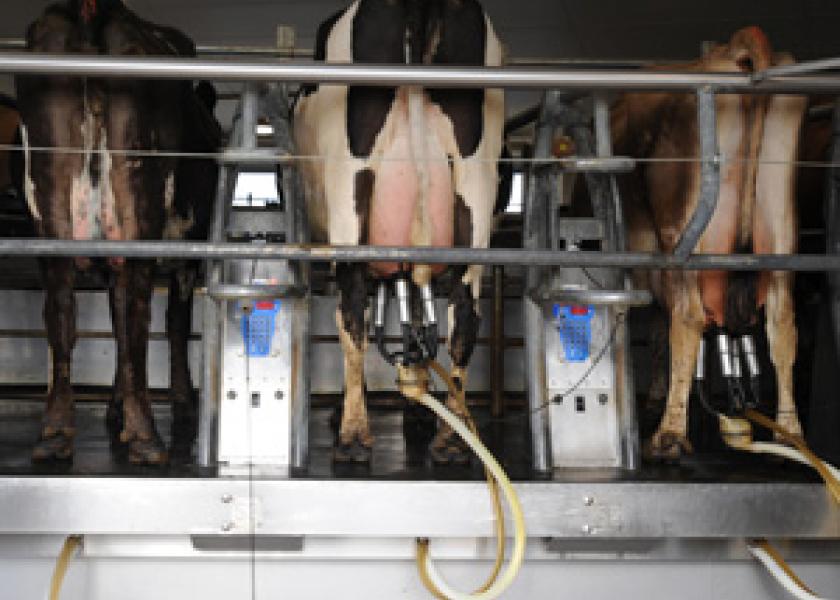Countdown to May 1

400,000 SCC level becomes de facto U.S. standard
On Nov. 22, 2011, USDA announced that individual U.S. dairy farms would have to ship milk with a somatic cell count (SCC) of fewer than 400,000 cells per milliliter to qualify for export to the European Union (EU).
The marketing requirement went into effect on Jan. 1, but dairy farms have until May 1 to comply. Farms can apply for a temporary exemption, called a "derogation," under special or seasonal circumstances.
The new standard has been under discussion since June 2009. In fact, on Jan. 20, 2010, USDA announced that the industry would have to meet the standard by Feb. 1 of that year. The announcement caused such an uproar that the agency issued a retraction and spent the next 22 months crafting the new requirement.
Bonus Content: European Health Certificate Program
- USDA Grading, Certification and Verification
- AMS Notice to the Industry
- Proposals for 400,000 SCC Wildly Different
- Demystifying Geometric Means
The standard for fluid Grade A milk in the U.S. remains at 750,000 cells/ml, with a 750,000 cells/ml standard for Grade B milk going into cheese sold domestically.
In the past, processors who exported dairy products to Europe merely had to certify that their silos and commingled tanker loads of milk from multiple farms met the 400,000 SCC limit. Now, as in Europe, individual farms must meet the standard.
"The 400,000 EU certification requirement is not a U.S. regulation, but simply meets a marketing requirement," says Ken Vorgert, chief of USDA’s Dairy Grading Branch. "Dairy farmers with milk above 400,000 SCC can still sell milk within the U.S. as long as it meets the 750,000 SCC level."
In effect, however, the 400,000 cells/ml level will become the new national standard. That’s because milk is processed into ingredients which then go into various dairy and other food products.
Once those ingredients enter the marketing stream, there is no way to differentiate between products made from high-SCC milk and low-SCC milk. So in order to comply, all milk will have to meet the standard unless a producer can find a local processor who will accept the milk (or can obtain a temporary exemption). "There are not a lot of these markets available, unfortunately," Vorgert acknowledges.
The EU standard is based on a three-month rolling average count for somatic cells (and a two-month rolling average for 100,000 cells/ml standard plate counts). The averages can be calculated using either an arithmetic or geometric mean, though using the geometric mean results in a lower cell count.
Although the program was instituted on Jan. 1, USDA has given dairies until May 1 to come into compliance on their three-month rolling average.
If a farm is out of compliance, it will not requalify for EU export certification until its three-month rolling average falls below 400,000 cells/ml, Vorgert says.
No one knows, of course, how many U.S. dairy farms will be out of compliance. Analysis by USDA’s Animal Improvement Programs Laboratory last year found that 7.8% of DHI herds might be out of compliance. These herds tend to be small, representing just 3.1% of the nation’s milk supply. Yet, extrapolated over the entire population of U.S. dairy farms, the study suggests that several thousand farms might not comply.
Many will likely come into compliance quickly, say co-op milk quality specialists. "We’ve had producers tell us they won’t meet the 400,000 level until they are forced to," says one Midwest milk quality specialist. "If they have a cow producing 80 lb. of milk and she has a cell count of 450,000, they won’t treat or cull her until they have to."
Small, traditional farms and farms in the Southeast quadrant of the country are more at risk of high SCC levels. One or two high-count cows on a small farm can greatly influence bulk tank SCC. In the Southeast, hot, humid weather for six months of the year encourages bacterial growth in bedding, creating greater risk of mastitis infection and higher somatic cell counts.
As this issue went to press in late December, many co-ops were still assessing how they would handle the requirement. But the response from John Wilson, senior vice president and chief fluid marketing officer of Dairy Farmers of America, was typical: "Our goal is to ensure our members are on a level playing field with European farmers. We expect to use the geometric mean and derogation options outlined by USDA."
Exemption Qualifications
USDA will allow farms to apply for one of two temporary exemptions, called "derogations," to the 400,000 SCC standard.
An annual derogation can be applied for if a farm is not meeting the 400,000 average but is making progress toward that standard, says Ken Vorgert, chief of USDA’s Dairy Grading Branch. "If the farm is at 750,000 SCC for six months of the year, we’re probably not going to grant derogation," he says. "And there have to be reasons, other than hygiene or sanitation, why the farm is out of compliance."
As long as the farm is making progress, USDA will likely renew the derogation for a second year.
The second type of derogation is for seasonal problems. In this case, a farm must be compliant for nine months of the year and have a consistent history of problems due to seasonality for the other three months. Seasonal derogations will have to be renewed every three years.
USDA will bill processors $136 per application. Processors, in turn, will likely pass that cost, plus their own administrative costs, on to farms. So farms could be looking at a total cost of $200 to $300 per derogation application.







